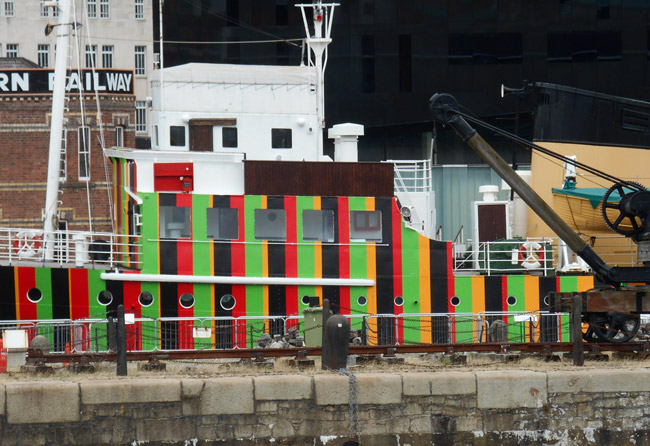
| HOME |
| NERVE |
| REVIEWS |
| ARCHIVE |
| EVENTS |
| LINKS |
| ABOUT US |
| CONTRIBUTORS |
| BACK ISSUES |
| CONTACT US |
Dazzle Ship: Induction Chromatique a Double Frequence pour L’Edmund Gardner Ship/Liverpool. Paris, 2014
Part of Liverpool Biennial Art
Festival 2014
Carlos Cruz-Diez
Canning Graving Docks, Liverpool
From 12th June 2014
Reviewed by Sandra
Gibson
Photograph by Geoff Edwards
The Skill of Linear Bewilderment
It’s rare to find anything harmlessly quirky in the realm of warfare; it’s unusual to find art deployed in saving lives but this actually happened during World War 1 and to a certain degree during World War 2. The practice of painting sea-going vessels in a style of optical illusion known as “dazzle” was devised by British zoologist John Graham Kerr and British artist Norman Wilkinson - although Picasso did claim it was invented by the Cubists – and supervised by Vorticist artist Edward Wadsworth, who became responsible for “dazzling” over 2,000 ships. Dazzle ships were not for the aesthetic amusement of the sailors it has to be stated, although it’s a nice idea; the aim was to confuse the eye of the enemy. Some camouflage techniques conceal the object by making it blend in with the surroundings. With dazzle ships the object remained visible, but confused the observer. The strong shapes and vivid contrasts, together with the complex geometric designs interrupting and intersecting one another, made it difficult to estimate a target’s range, speed and heading in order to gauge the optimum position of attack. Moreover, to avoid making classes of vessels recognizable, each ship’s dazzle treatment was unique - a variety of colour schemes being used.
 |
Bearing in mind that much of this dazzle painting took place in war-time Liverpool’s dry docks - for example, the Canning Graving Docks - the pilot ship Edmund Gardner becomes the contemporary canvas for a bright addition to the Liverpool waterfront. Painted by Venezuelan kinetic artist Carlos Cruz-Diez, this bright and playfully coloured dazzle ship is aptly moored in Canning Graving Docks where its warring predecessors were given the razzle-dazzle treatment.
The Beatles’ song, Yellow Submarine humorously subverted the combatant ethos of the submariner and similarly, Carlos Cruz-Diez subverts the original grim reason for painting ships in this way with his snappy striped design for the Edmund Gardner. I felt a bit let down that it wasn’t more kinetic, as the original dazzle ships were. The work has been realised by a team of painters from Cammell Laird in association with International Paint and it’s a bit sad that it will be de-dazzled at the end of 2015.
Although there was not very much evaluation of its deterrent success in battle, dazzle has attracted the subsequent attention of artists. Edward Wadsworth painted a series of canvases after the war and there is a tiny – four works to be precise – exhibition of his wood cuts at the Walker Gallery. Their small size does not diminish the decorative power of Wadsworth’s machine-age vision and the wood cut is an ideal medium for the definition of structure and for emphasising contrast. More recent developments in modern art - such as Op Art - have exploited the kinetic properties and optical illusions inherent in the skill of linear bewilderment.
The Edmund Garner project links the historic with the subversive and, more importantly as far as I was concerned, it alerted me to something I knew nothing about.